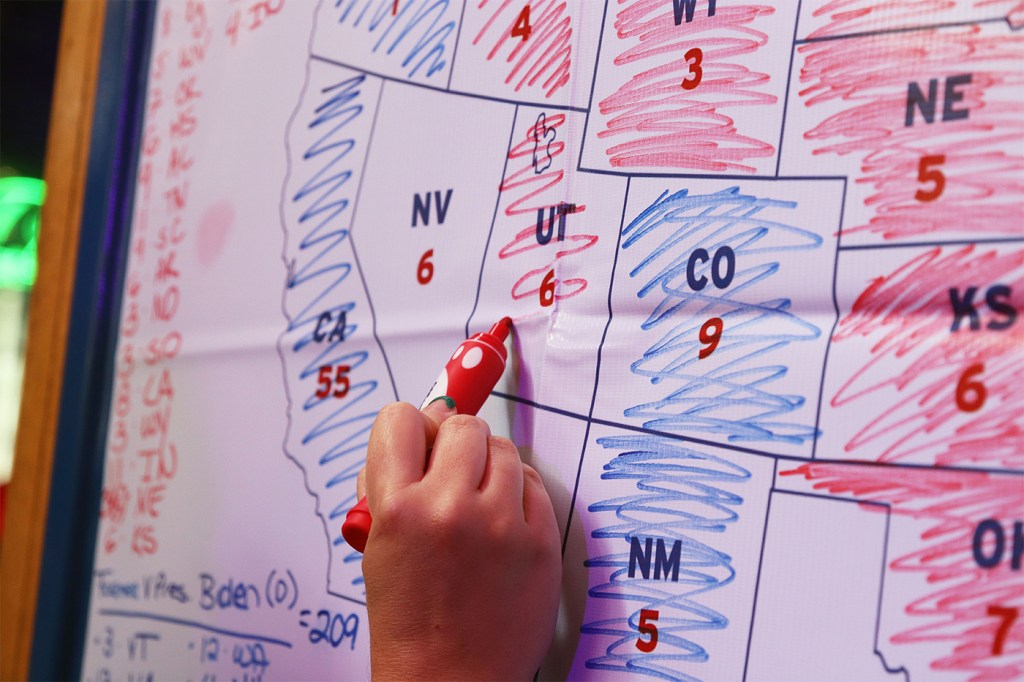With less than 30 days before Election Day, what are Harris’ and Trump’s paths to victory?
“When you’re getting down to such tiny margins, it’s really a flip of the coin,” says David Lazer, university distinguished professor of political science and computer science at Northeastern.

Election Day is less than 30 days away and the presidential race remains a statistical dead heat, with Vice President Kamala Harris holding perhaps a slight lead over former President Donald Trump.
In seven swing states — Michigan, Pennsylvania, Wisconsin, North Carolina, Georgia, Arizona and Nevada — the race is as tight as ever.
Predictably, news outlets have begun their Electoral College mapping, offering early sketches of the two candidates’ different pathways to obtaining the 270 electoral votes required to clinch the presidency.
The story of the last several election cycles is that presidential contests have, in a polarized nation, gotten a lot tighter. Four years ago, Joe Biden carried Georgia and Arizona by a margin of roughly 10,000 votes — and this year may be even closer, says David Lazer, university distinguished professor of political science and computer science at Northeastern.

“When you’re getting down to such tiny margins, it’s really a flip of the coin,” says Lazer, who conducts polling analysis.
Which is why delving too deeply into the Electoral College map — even a month out — is an exercise in pure speculation.
“Sometimes there’s a little bit too much of an emphasis put on these different pathways to victory. The reality is there are multiple pathways for both campaigns to victory, and that there will likely be some mixing and matching,” Lazer says.
But there are a couple of key points.
Featured Posts
Pennsylvania: the coveted prize
It’s no secret that Pennsylvania is key for both campaigns, but especially for Trump. That’s because, assuming that Trump wins all the same states he won in 2020, he could win the presidency by flipping Pennsylvania and one other state. Without it, Trump would need to carry Wisconsin, Arizona and Michigan to win the White House.
On the other hand, if Harris can’t win Pennsylvania, she’ll need to take either Georgia or North Carolina. Pennsylvania, Michigan and Wisconsin have all voted the same way in every election cycle since 1992 (2016 was the only occasion that the trio didn’t swing Democrat). Everything else being equal, Harris can get to 270 with wins in each of those states.
If Trump carries Pennsylvania, Georgia and North Carolina, the remaining battleground states won’t matter in the outcome.
Pennsylvania is worth 19 electoral votes, putting the state at number six in terms of the most electoral votes across all 50 states.
North vs. South
With polls showing Harris leading by a point or two in Pennsylvania, Michigan and Wisconsin, and Trump leading by a point or two in Arizona, North Carolina and Georgia, one storyline that could emerge in November is a battle between Northern and Southern states.
“The question of a path to victory in the North or the South is a little misleading in the sense that ultimately you just have to get to 270, and there are also ways you could put the vote together that include a bit of both regions,” Lazer says.
“We work on the assumption that there’s some correlation in how these states lean,” Lazer says. “For example, we like to think that Wisconsin and Michigan are sort of correlated in a way that Georgia and Michigan are not. And that’s probably true, but at this point it’s likely to be very close in all of these states.”
Of course, Harris is running on a condensed timeline following Biden’s abrupt exit from the race in July. Does the fact that she hadn’t “earned” her party’s nomination the traditional way diminish her chances of competing in these key states?
“I haven’t seen any evidence of that,” Lazer says.
“Of course, again, when we get down to margins of tenths of a percent, no one has such precision to say, this is what is swinging 50,000 votes in Wisconsin, which could be the difference, right?” he says. “We have to be very careful about what we say about the precision of our capacity to speak to that question. I don’t see it swinging votes in the realm of a few percentage points, but a few tenths of a percent? That would be beyond our — and anyone else’s ability — to speak to.”











